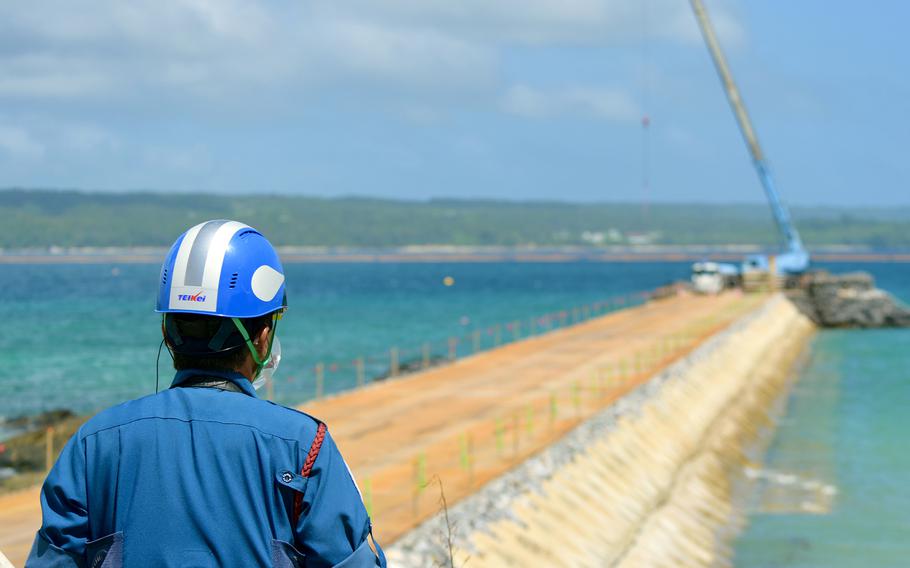
Construction work continues on a Marine Corps runway into Oura Bay at Camp Schwab, Okinawa, Sept. 15, 2022. Work to reclaim a portion of seabed for a new Marine Corps airfield on Okinawa began Wednesday after a Japanese Cabinet minister approved job changes over local objections. (Frank Andrews/Stars and Stripes)
CAMP FOSTER, Okinawa — Work to reclaim a portion of seabed for a new Marine Corps airfield on Okinawa began Wednesday after a Japanese Cabinet minister approved job changes over local objections.
The Ministry of Defense resumed the work after Tetsuo Saito, minister of land, infrastructure, transport and tourism, approved permits for design changes over the head of Okinawa Gov. Denny Tamaki, a staunch opponent of the U.S. military presence.
Chief Cabinet Secretary Yoshimasa Hayashi announced the work resumption at a Wednesday press conference in Tokyo.
“We received a report from the Ministry of Defense that the construction on the Oura Bay site will begin today as the necessary preparations have been made,” he said.
The runway is being built on reclaimed land in Oura Bay in the rural Henoko area of Okinawa to replace Marine Corps Air Station Futenma in urban, densely populated Ginowan.
Hayashi said construction will take nine years and three months.
Hayashi said that “steadily moving forward with the construction” will eventually eliminate hazards at MCAS Futenma, which is surrounded by homes and schools.
Relocating the airfield to the Henoko region of Okinawa “is the only solution” he said.
Prime Minister Fumio Kishida also endorsed the relocation plan.
“A situation in which the Futenma air station, said to be the world most dangerous, becomes fixed in its current location must absolutely be avoided,” he told reporters in Tokyo on Wednesday evening.
Tamaki, in a statement Wednesday on the prefectural website, said resuming construction at the site on the Marine Corps’ Camp Schwab is “extremely regrettable.” Work started without any discussion with the prefecture, as Tokyo agreed when former Gov. Hirokazu Nakaima approved the project in 2013.
“I ask the Japanese government to have a sincere dialogue with Okinawa prefecture to resolve the issue, after acknowledging the serious problem caused by this forced reclamation work that is neither necessary nor rational and immediately halting the construction of the Henoko new base, which will add even more hardship to the Okinawa’s troubled history,” Tamaki wrote.
All Okinawa, a group opposed to the presence of U.S. bases on the island, plans to protest at Henoko on Friday.
Group director Yuji Fukumoto said the national government behaved in cowardly fashion by deceiving its citizens and avoiding conversations about the airfield construction.
“Instead of respecting the Okinawan people and lightening the burden, the government is doing the exact opposite,” he said by phone Thursday.
Tamaki repeatedly refused to approve permits for design changes at the Oura Bay site. Saito eventually approved the permits on Dec. 28 after Tamaki ignored a Dec. 25 deadline from Fukuoka High Court to do so by Dec. 25. The court handed Saito that authority if Tamaki refused.
Tamaki has appealed the case again to Japan’s Supreme Court, but the Local Autonomy Act states that work may proceed while the appeal is pending.
Tamaki in November 2021 denied pending requests for permits at Schwab but was overruled by Saito, who deemed the governor’s decision “illegal and unreasonable.”
Tamaki began a protracted legal battle, filing and losing three suits to block the permits, culminating in a September loss at the Supreme Court.
The governor argued that the soft seabed in the construction zone poses a hazard and that Tokyo had failed to consider the environmental impact on the endangered dugong, a cousin of the manatee protected by Japanese law.
The project, originally slated for completion by 2014, will now take until at least 2032 and cost the Japanese government $6.9 billion, at last estimates.